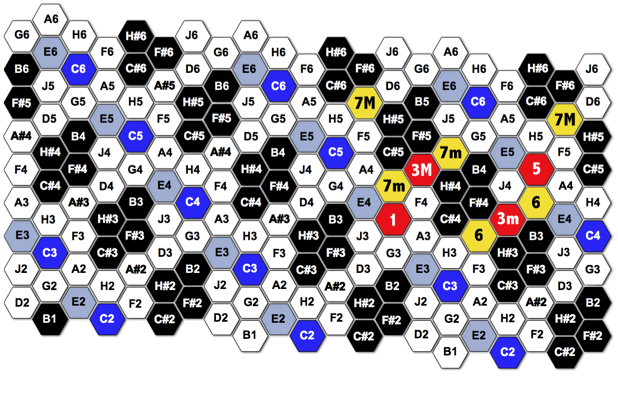
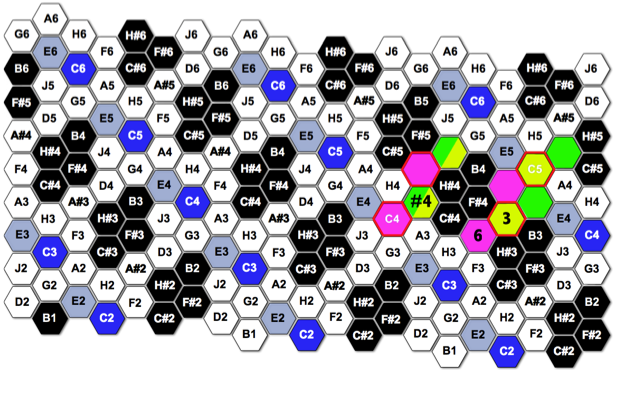
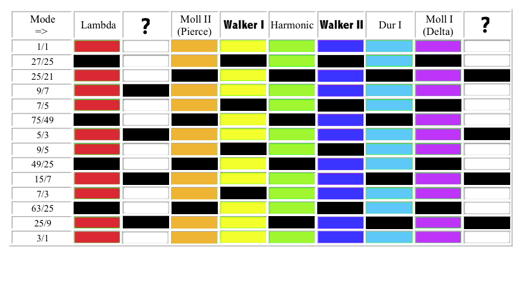
Bohlen-Pierce Scale Modes and Chords






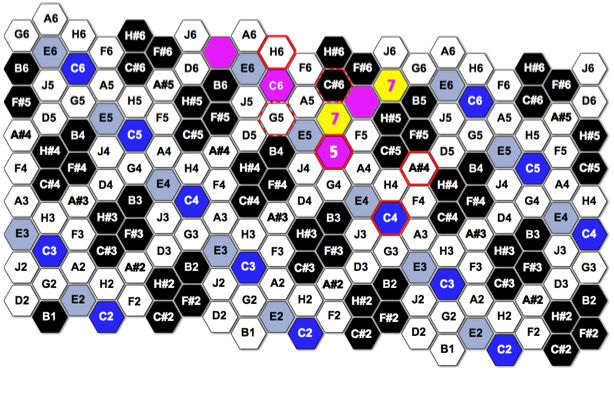

Early BP modes:
This chart shows the modes that were documented when I started my research at NYU in 2001. I came to the conclusion that Lambda mode is the best tonic mode of choice, and most of the prior research seemed to be pointing in that direction.
Lambda contains all of the frequency ratios that the tuning was derived from (marked with * in the left column), it starts with a hearty wholetone and ends with a lead tone, never has two whole steps in a row, and contains a wider variety of harmonic sounding chords than the other modes. In addition, if Lamda mode is the tonic mode (all of the white notes from C to C), most of the other modes, with the exception of Dur II and Gamma, fall on other white-note scales as shown below.
*
*
*
*
*
*
*


The Lambda family of modes:

Four new modes complete the Lambda family:
Using a variety of chords and progressions I derived purely by ear, I developed two new modes, attempting to use as many of the notes in the chords as possible. Ultimately, I found that by modifying Moll 1 and Moll 2 slightly, two new modes were created that fit the bill.
The Dur II family of modes:
Only chord progressions 1, 2 and 3 are shown here.
Coincidentally, these two new modes fit in to two of the blank spots in the Lambda family. I pointed out to Heinz Bohlen that there were still two missing modes. He named them Walker A and Walker B in his circle chart to the left. This completed the Lambda family of modes!
Below you can listen to the Lambda family of modes, and also Dur II and Gamma. I explain how I developed two new modes which coincidentally filled in two of the four blanks (the white notes from F to F, and H to H), and observed there were still two modes with no names (D to D and B to B). Apparently this was the first time the modes were put into any sort of logical order. Heinz Bohlen drew out a Lambda family wheel and named the modes I developed Walker I and Walker II. The remaining two modes, he named (temporarily at least) Walker A and Walker B.
Although Dur II and Gamma do not fit in the Lambda family of modes, they are compatible with each other. Heinz' original Bohlen-Pierce Scale keyboard that he built in 1972 was referencing Dur II mode (see Keyboards). It only differs from Lambda in the last step. Lambda ends with a leading tone, whereas Dur II ends with a wholetone.
Lambda family wheel by Heinz Bohlen, 2001
The following charts show modes and chords on the "Harmonic Table". See the Keyboards section for more info and to see life-sized versions of these keyboard layouts. Although Lambda is the tonic mode of choice, I ultimately settled on Dur II mode on this particular keyboard because it is visually more clear with the black notes split up, and the only difference is that the A# and B colors are switched. Semitones run horizontally to the right, other different intervals run vertically and diagonally each way. Observe that there are duplicate notes, so it is possible to play these modes and chords a number of different ways, and with either hand.
The modes can be played, starting on C and ending on the C above, by simply skipping the black keys. The numbers show the order to hit the keys.
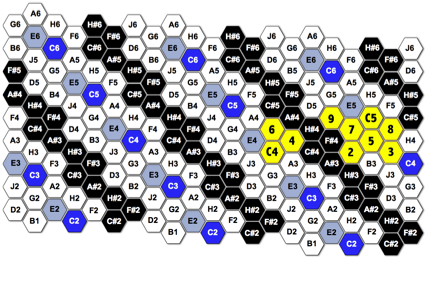
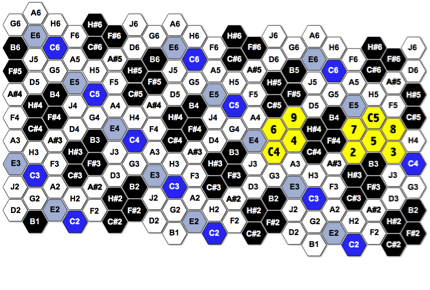
Dur II mode
Lambda mode
Harmonic Ratios in the Bohlen-Pierce Scale
This shows where the "diatonic" frequency ratios fall on the Harmonic Table arranged for Lambda mode. The three charts show (in red) where the Phase I triad (or "Wide" triad), Phase II triad and Phase III triad (the "Narrow" triad) fall on the keyboard. See my research paper or the official Bohlen-Pierce site to learn more about these ratios and triads.
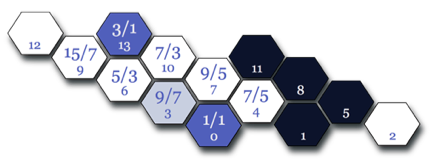
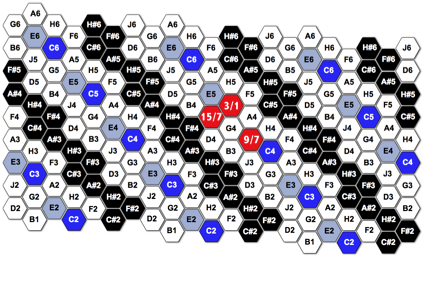
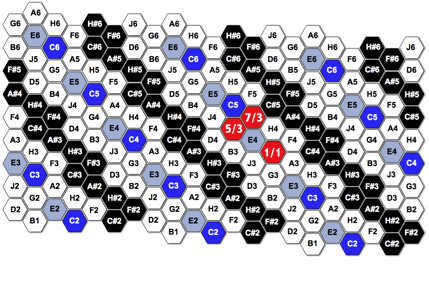

Phase I triad
Phase II triad
Phase III triad
Thanks goes
to X. J. Scott for
creating this diagram!
Chords in the Bohlen-Pierce Scale
As I stated above, I ultimately decided that the Dur II Mode layout on the Harmonic Table is better than Lambda Mode, mainly because the black keys are split up, and the only difference is that the A# and B colors are switched.
In addition to the three main diatonic triads above, I've mapped out some chords (below) as an experiment, with the 3's, #4, 5's, 6's and 7's referencing similar intervals in the 12 tone tuning. The Bohlen-Pierce Scale has a harmony all it's own and is completely alien to the 12 tone tuning, however, these chords (sort of) emulate chords that are familiar to Western ears. This is accomplished by playing "10th's" to emulate "3rds", and "12ths" to emulate "5ths", etc, in some cases. The last chart shows a couple of ways to modulate down a "fifth", meaning playing what sounds vaguely similar to playing a V chord going to a I chord in the 12 tone tuning.
I feel this was a necessary exercise, but what will be more interesting will be to find chord progressions that create tension and resolve, but are not familiar in any way to the Western ear. So far, I have not analyzed my own Bohlen-Pierce Music to see what I have done. Whatever I figure out in research goes "out the window" when I compose, and write purely by ear every time. When I get some time I will map out chords in my own BP songs, and add them to this site.
"Major" triad - Play 1 - 3M - 5 to emulate a 12-tone major triad. This is not to be confused with Heinz's original "major" triad which is now called the "wide triad".
"Minor" triad - Play 1 - 3m - 5 to emulate a 12-tone minor triad. This is not to be confused with Heinz's original "minor" triad which is now called the "narrow triad".
"6 chord" - Play a "major" or "minor" triad and add one of the two 6's. NOT BOTH.
"minor 7" - Play a "minor" triad with one of the two 7m's. NOT BOTH.
"major 7" - Play a "major" triad with one of the two 7M's. NOT BOTH.
"dominant 7"- Play a "major" triad with one of the two 7m's. NOT BOTH.
"minor-major 7"- Play a "minor" triad with one of the two 7M's. NOT BOTH.
"6 major & 6 minor" chords - Play the pink keys for the 6 chords. The upper right pink key is the major 3rd for the 6 chord and the lower left pink key labeled "C4" is the minor 3rd.
"3 major & 3 minor" chords - Play the yellow keys for the 3 chords. The upper right yellow key is the major 3rd for the 3 chord and the lower left yellow key is the minor 3rd.
"#4 major & #4 minor" chords - Play the green keys for the #4 chords. The upper left green key is the major 3rd for the #4 chord and the lower right green key is the minor 3rd.
The keys outlined in red are the major and minor 1 (tonic) chords.
There is no equivalent of a 4 chord in BP.
"resolving down a fifth" (V7 to I Maj)
There are plenty of "7 chords", but it is tricky to "resolve down a fifth" which is what any ear from the Western world will be waiting for. The trick is to resolve to a very wide "1 chord".
"5 chord" - Play the pink keys labeled 5 and C6, plus one of the other pink keys for the "major 3rd", NOT BOTH. Add one of the yellow 7 keys to create a "dominant 7 chord". This is a different fingering than the dominant 7th cord above, due to the logistics of "resolving down a fifth", as you will see.
"1 chord" - The 1 chord notes are outlined in red, or dotted red lines. Play they key labeled C4, 5 and choose the other notes in the chord, keeping leading tones in mind. If you played the topmost pink key, resolve to H6. Don't play G5 or C#6 at the same time. Choose one or the other.